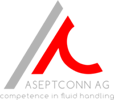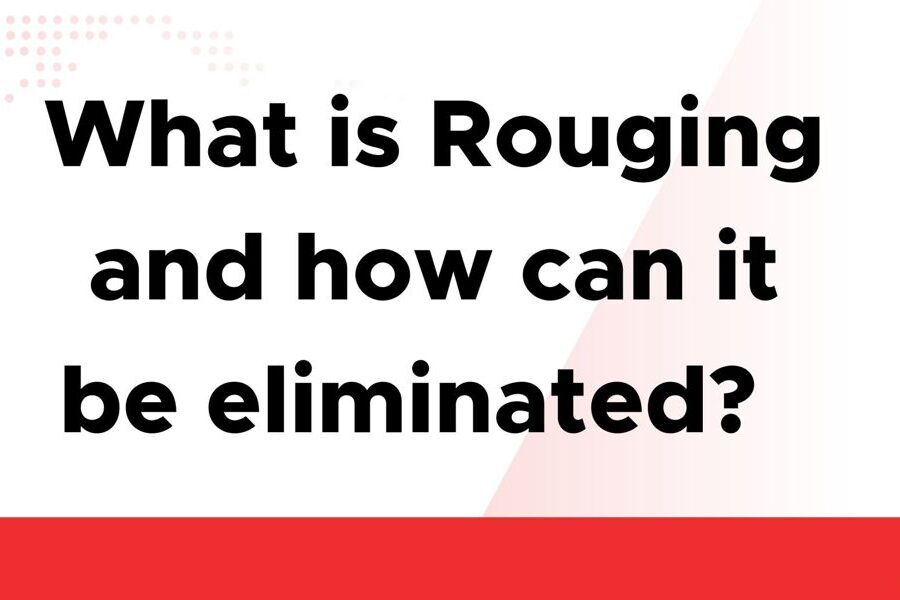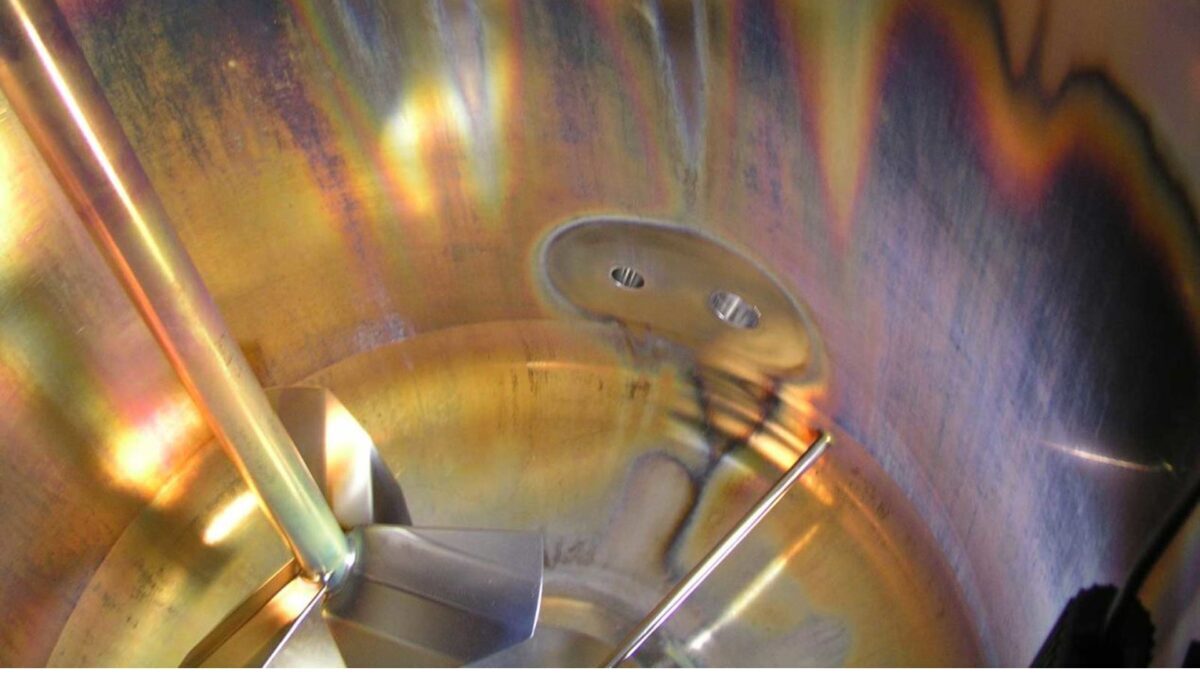
What is rouging?
Rust is caused by the breaking up of the naturally existing passive layer on stainless steel surfaces. This favors the formation of oxides of iron and other metals and leads to discoloration of the surface. The phenomenon of rouging shows a high concentration of iron oxides instead of chromium oxides. The chromium oxides that cover the surface of stainless steel serve to protect the metal, thus reducing its permeability to ions from the outside. This is particularly the case if the stainless steel surfaces are exposed to high temperatures (> 50 °C) and/or hot water with low ion and oxygen content for a prolonged period, e.g. in pure water (PW), water for injections (WFI) or in pressure vessels that can be sealed gas-tight (autoclaves).
The Rouging Classes
There are 3 classes of rouging. These are classified according to their coloration:

Class 1: Movable rouging that comes from the outside. It is wipeable, does not stick to surfaces and does not affect the passivated layer. Its color varies from orange to orange-red. The most common type is iron oxide. To determine if the rouging is mobile, you can wipe with a white cloth. If the cloth catches many reddish particles, you know it is class 1.
Class 2: Rouging that cannot be wiped off and adheres to the surfaces. Here, the passivated layer is destabilized. The colors recovered are orange, red, violet and blue. The most common chemical form is hematite.
Class 3: Non-wipe rouging glazed on the surface. Its occurrence is related to high temperatures and the presence of halogens. The coloration is purple and black. The most common form is magnetite and metal chlorides.
The risks of rouging
Rust formation is unacceptable in many processes because the condition is unstable and oxidation particles can detach from the surface and contaminate the transported media. Furthermore, oxidation deposits on stainless steel jeopardize the safety of processes based on defined surface conditions (surface texture and roughness). This phenomenon favors the binding of bacteria as well as biofilms.
If the corrosion goes too deep, the equipment (or production plant) will be severely damaged and will need to be completely replaced.
What solutions are there against rouging
There are 3 ways to avoid or eliminate rouging
- Preventive management of rouging by clearly defining the processes and responsibilities and already monitoring them preventively. As a rule, rouging is controlled by the production and maintenance teams. It is therefore necessary that the procedures are approved and released by the quality assurance department.
- The following control options must be set up:
- Visual inspection, where the equipment is visually inspected according to the SOP (Standard Operating Procedure) rules. This type of inspection is also used to control the development of rouging if it is already present in the equipment.
- The white cloth test, which is used to visually determine if the installation has migrating rouging (Class 1).
- Avoiding or limiting rouging can be achieved by selecting products that meet the company\'s quality standards on the one hand, and by making sure that the equipment is used properly on the other.
- The surface quality of the equipment
- Stainless steel Inox 316L with certificate 2.2
- Surface quality (roughness test)
- Quality of welds (with the complete welding book)
- Cleanliness of the surface
- Maintenance of the plants and equipment:
- Take the necessary measures when aggressive raw materials are used.
- Adjust and measure the time during which the equipment is exposed to corrosive substances.
- Ensure regular monitoring and maintenance of the equipment.
- Derouging involves derusting equipment using chemical, electrochemical or mechanical processes to treat the rouging present on the equipment.
How does derouging work?
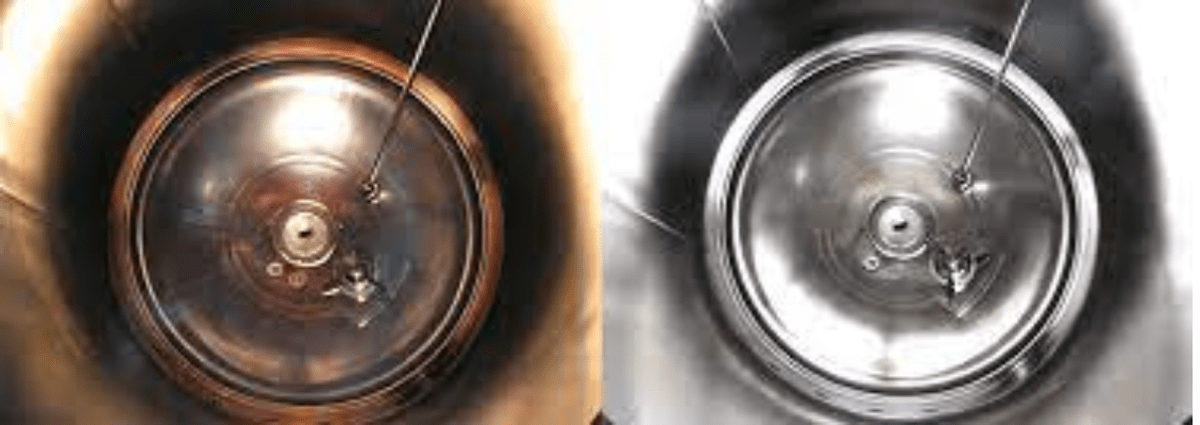
Derouging can be done in three different ways:
- Chemical method
- This is the most common method used to deroughen oxidized parts. Mixtures of more or less acidic products are used to remove the oxidation layer from rusted parts.
- Electrochemical process
- This method differs from a chemical process in that electric current is used instead of a mixture of chemicals to achieve the desired conversion.
- Mechanical method
- This method is used when the surface is too attacked by oxidation and becomes too rough. It consists in the application of mechanical methods such as grinding, polishing, pickling or rubbing with abrasives. After this procedure, it is essential to thoroughly clean the treated workpiece.
After a derouging process, it is important to passivate the workpiece so that it is once again protected against rust. The mechanical process ensures that the passivated layer is rebuilt more quickly. Passivation not only protects the metal from rust, but also metal parts such as pipe connections and hose clamps from further surface contamination. This extends service life and reduces maintenance costs.
What does the passivation consist of?
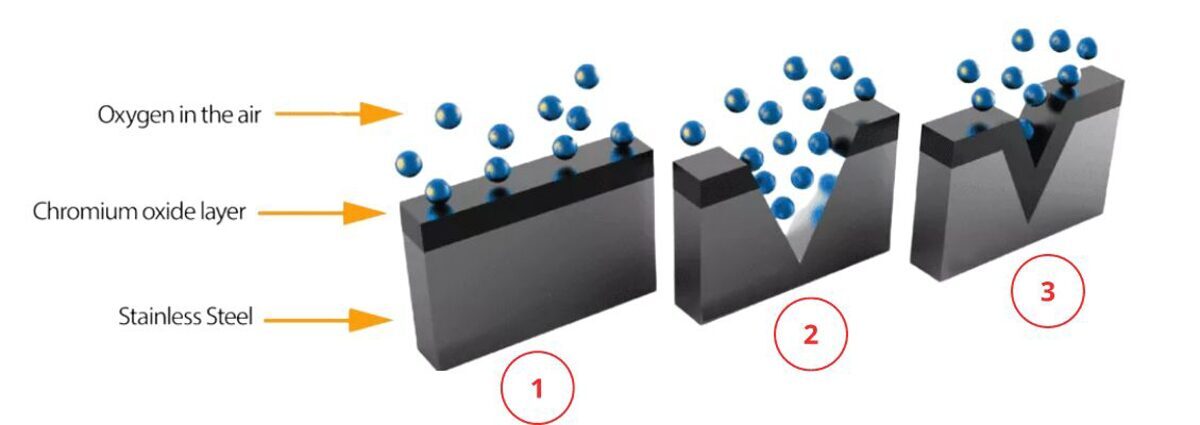
The passivation process of stainless steel occurs naturally when exposed to air or other oxygen-containing environments. It is therefore a natural protection against corrosion. Steel parts with a chromium content of more than 11% naturally form a passive layer that protects them from corrosion.
When stainless steel is exposed to various chemicals or improper treatment, it can make the metal susceptible to rust. This is because a metal part that has suffered damage such as scratches or cracks makes it more difficult for the passive layer to reform on its own. This leads to corrosion when the metal gets wet or exposed to corrosive chemicals. Also, with certain treatments, iron or steel particles from tools or abrasive particles can be deposited on the surfaces of some stainless steel components. When these particles remain, they promote corrosion and result in rust stains. Processes that promote rusting: Rolling, forming, machining, pressing, grinding, running-in.
Passivation is used to remove excess iron or iron compounds that are on the surface of stainless steel parts. In the passivation method, a chemical treatment is applied to the metal, which removes the contamination and accelerate the passivation process. It is also possible to perform passivation by electropolishing.
Conclusion
It is important to monitor equipment regularly to avoid rouging problems. Continuous and careful monitoring can prevent long-term production losses. Since rouging can be the cause of contamination, it must be dealt with quickly. To help you combat this phenomenon, Asepctonn has set up a service for scheduled maintenance of your equipment.
 We visit you on site to analyze your production equipment |  We advise you on the best procedures to restore your installation |  We will create a work plan with you so that you can meet your production deadlines. |
If you have any need, do not hesitate to contact us. Our technical department and our engineers are always at your disposal to provide you with competent support for your projects.
